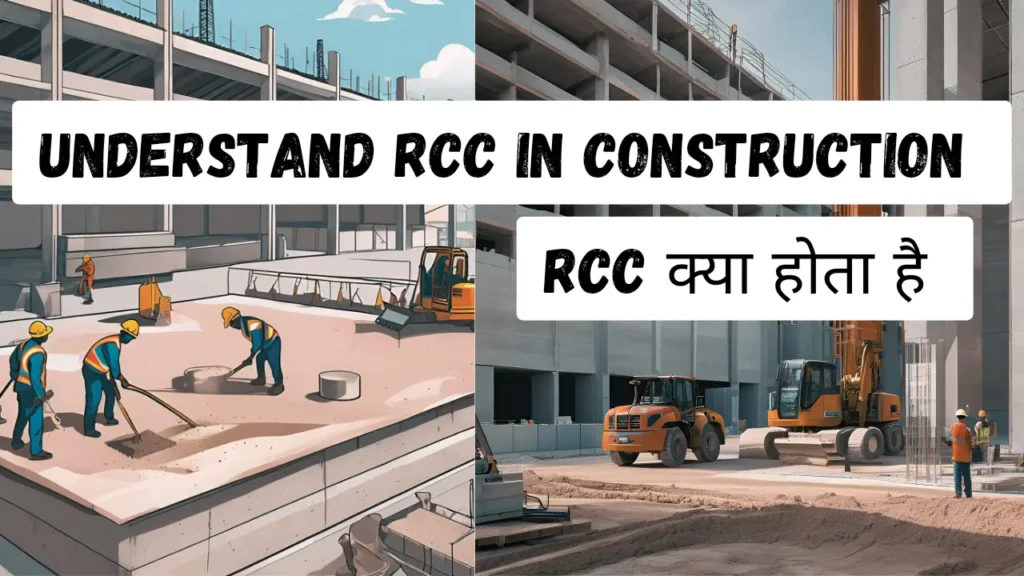Table of Contents
Introduction of RCC in Construction
Building strong, durable, and long-lasting structures is a crucial aspect of construction projects. One material that has stood the test of time and continues to be widely used is reinforced cement concrete, commonly known as RCC. In this comprehensive blog post, we’ll delve into the full form of RCC, its applications, advantages, and disadvantages, helping you understand why it is a go-to choice for construction professionals.
What is RCC?
RCC, or Reinforced Cement Concrete, is a composite material made by combining concrete and steel reinforcement. The concrete provides compression strength, while the steel reinforcement, typically in the form of rebar (reinforcing bars) or welded wire mesh, adds tensile strength. This combination results in a sturdy and versatile material that can withstand various loads and stresses.
RCC Full Form in Civil Engineering
In the field of civil engineering, RCC plays a vital role in the construction of various structures, including buildings, bridges, dams, and retaining walls. The full form of RCC in civil engineering is “Reinforced Cement Concrete,” which emphasizes the use of cement as the primary binding agent and the reinforcement provided by steel.
Full Form of RCC in Road Construction

RCC is also widely used in road construction, where it is known for its durability and load-bearing capacity. The full form of RCC in road construction is “Reinforced Cement Concrete Pavement.” RCC pavements are constructed by laying a reinforced concrete slab directly on a prepared base or subgrade, providing a smooth and long-lasting surface for vehicular traffic.
Advantages of RCC
RCC offers several advantages that make it a popular choice for construction projects:
- Strength and Durability: The combination of concrete and steel reinforcement provides exceptional strength and durability, enabling RCC structures to withstand harsh environmental conditions and heavy loads.
- Versatility: RCC can be molded into various shapes and sizes, making it suitable for a wide range of construction projects, from residential buildings to large-scale infrastructure projects.
- Fire Resistance: Concrete has excellent fire-resistant properties, making RCC structures safer and more resistant to fire hazards.
- Low Maintenance: RCC structures require minimal maintenance over their lifetime, reducing long-term costs and ensuring longevity.
- Sustainability: Concrete is a relatively eco-friendly material, and RCC construction can contribute to sustainable building practices when combined with recycled materials and efficient construction methods.
Disadvantages of RCC
While RCC offers many advantages, it also has some drawbacks:
- High Initial Cost: The materials and labor required for RCC construction can be more expensive compared to alternative construction methods.
- Heavyweight: RCC structures are generally heavier than other construction materials, which may require more robust foundations and increase transportation costs.
- Reinforcement Corrosion: If the steel reinforcement is not properly protected or maintained, it can corrode over time, compromising the structural integrity of the RCC.
- Cracking: RCC structures are susceptible to cracking due to factors such as temperature changes, shrinkage, and cyclic loading.
- Limited Tensile Strength: While RCC excels in compression, its tensile strength is relatively low, necessitating the use of steel reinforcement.
Why Use RCC in Construction?
Also Read
Learn Bar Bending Schedules in Civil Engineering
Types of Steel Bars in Construction: A Comprehensive Guide
Despite its disadvantages, RCC remains a popular choice in construction due to its numerous advantages and proven track record. Its strength, durability, and versatility make it suitable for a wide range of projects, from residential buildings to large-scale infrastructure developments. Additionally, advancements in construction materials and techniques have addressed some of the drawbacks, such as the use of corrosion-resistant reinforcement and improved crack control methods.
Conclusion
Understanding the full form of RCC and its applications is essential for construction professionals and anyone interested in the built environment. As a composite material that combines the strengths of concrete and steel reinforcement, RCC offers numerous advantages, making it a popular choice for various construction projects. While it has some drawbacks, its benefits often outweigh its limitations, ensuring its continued use in the construction industry. By exploring the full form of RCC, its advantages, and disadvantages, you can make informed decisions and contribute to the creation of safe, durable, and sustainable structures.
DETAIL EXPLANATION ABOUT RCC YOUTUBE VIDEO
FAQ
What is RCC and PCC?
RCC: Reinforced Cement Concrete combines concrete and steel for strength.
PCC: Plain Cement Concrete is a mixture of cement, sand, aggregate, and water without reinforcement.
Why is RCC used?
RCC is used for its strength, durability, and ability to bear heavy loads.
RCC का वापरला जातो?
RCC चा वापर मजबूत आणि टिकाऊ बांधकामासाठी केला जातो.
How much does a 1000 square foot slab cost?
1000 square foot RCC slab may cost between ₹1,50,000-₹2,00,000.
How much cement is required for a 1000 sq ft RCC house?Approximately 400-450 bags of cement are required for a 1000 sq ft RCC house.

Hi! I’m Sandip, a civil engineer who loves sharing about Civil Engineering & new ideas and tips. My blog helps you learn about engineering in a fun and easy way!

